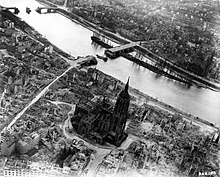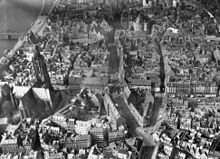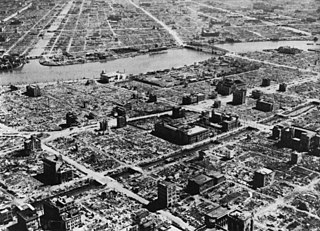
Strategic bombing is a systematically organized and executed attack from the air which can utilize strategic bombers, long- or medium-range missiles, or nuclear-armed fighter-bomber aircraft to attack targets deemed vital to the enemy's war-making capability. It is a military strategy used in total war with the goal of defeating the enemy by destroying its morale, its economic ability to produce and transport materiel to the theatres of military operations, or both. The term terror bombing is used to describe the strategic bombing of civilian targets without military value, in the hope of damaging an enemy's morale.
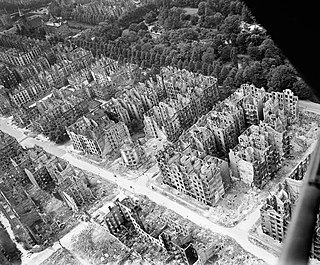
The Allied bombing of Hamburg during World War II included numerous attacks on civilians and civic infrastructure. As a large city and industrial centre, Hamburg's shipyards, U-boat pens, and the Hamburg-Harburg area oil refineries were attacked throughout the war.
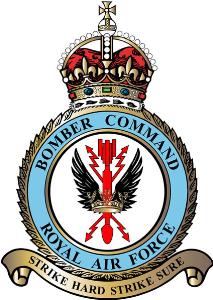
RAF Bomber Command controlled the Royal Air Force's bomber forces from 1936 to 1968. Along with the United States Army Air Forces, it played the central role in the strategic bombing of Germany in World War II. From 1942 onward, the British bombing campaign against Germany became less restrictive and increasingly targeted industrial sites and the civilian manpower base essential for German war production. In total 501,536 operational sorties were flown, 2.25 billion pounds of bombs were dropped and 8,325 aircraft lost in action. Bomber Command crews also suffered a high casualty rate: 55,573 were killed out of a total of 125,000 aircrew, a 44.4% death rate. A further 8,403 men were wounded in action, and 9,838 became prisoners of war.

The Channel Dash was a German naval operation during the Second World War. A Kriegsmarine squadron comprising two Scharnhorst-class battleships, Scharnhorst and Gneisenau, the heavy cruiser Prinz Eugen and their escorts was evacuated from Brest in Brittany to German ports. Scharnhorst and Gneisenau had arrived in Brest on 22 March 1941 after the success of Operation Berlin in the Atlantic. More raids were planned and the ships were refitted at Brest. The ships were a threat to Allied trans-Atlantic convoys and RAF Bomber Command attacked them from 30 March 1941. Gneisenau was hit on 6 April 1941 and Scharnhorst on 24 July 1941, after dispersal to La Pallice. In late 1941, Adolf Hitler ordered the Oberkommando der Marine to plan an operation to return the ships to German bases in case of a British invasion of Norway. The short route up the English Channel was preferred to a detour around the British Isles for surprise and air cover by the Luftwaffe and on 12 January 1942, Hitler gave orders for the operation.

World War II (1939–1945) involved sustained strategic bombing of railways, harbours, cities, workers' and civilian housing, and industrial districts in enemy territory. Strategic bombing as a military strategy is distinct both from close air support of ground forces and from tactical air power. During World War II, many military strategists of air power believed that air forces could win major victories by attacking industrial and political infrastructure, rather than purely military targets. Strategic bombing often involved bombing areas inhabited by civilians, and some campaigns were deliberately designed to target civilian populations in order to terrorize them and disrupt their usual activities. International law at the outset of World War II did not specifically forbid the aerial bombardment of cities – despite the prior occurrence of such bombing during World War I (1914–1918), the Spanish Civil War (1936–1939), and the Second Sino-Japanese War (1937–1945).

The second Schweinfurt raid, also called Black Thursday, was a World War II air battle that took place on 14 October 1943, over Nazi Germany between forces of the United States 8th Air Force and German Luftwaffe fighter arm (Jagdwaffe). The American bombers conducted a strategic bombing raid on ball bearing factories to reduce production of these vital parts used in all manner of war machines. This was the second attack on the factories at Schweinfurt. American wartime intelligence claimed the first Schweinfurt–Regensburg mission in August had reduced bearing production by 34 percent but had cost many bombers. A planned follow-up raid had to be postponed to rebuild American forces.
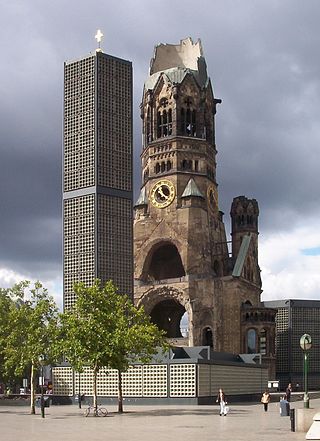
Berlin, the capital of Germany, was subject to 363 air raids during the Second World War. It was bombed by the RAF Bomber Command between 1940 and 1945, the United States Army Air Forces' Eighth Air Force between 1943 and 1945, and the French Air Force in 1940 and between 1944 and 1945 as part of the Allied campaign of strategic bombing of Germany. It was also attacked by aircraft of the Red Air Force in 1941 and particularly in 1945, as Soviet forces closed on the city. British bombers dropped 45,517 tons of bombs, while American aircraft dropped 22,090.3 tons. As the bombings continued, more and more people fled the city. By May 1945, 1.7 million people had fled.
The Transportation Plan was a plan for strategic bombing during World War II against bridges, rail centres, including marshalling yards and repair shops in France with the goal of limiting the German military response to the invasion of France in June 1944.

The German city of Cologne was bombed in 262 separate air raids by the Allies during World War II, all by the Royal Air Force (RAF). A total of 34,711 long tons (35,268 t) of bombs were dropped on the city, and 20,000 civilians died during the war in Cologne due to aerial bombardments.
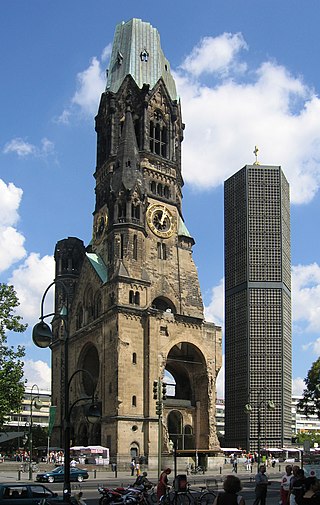
The Battle of Berlin was a bombing campaign against Berlin by British RAF Bomber Command, along with raids on other German cities to keep German defences dispersed, and which was a part of the bombing of Berlin during the strategic bombing of Germany in World War II. Air Chief Marshal Arthur Harris, Air Officer Commanding-in-Chief (AOC-in-C) Bomber Command, believed that "we can wreck Berlin from end to end if the USAAF come in with us. It will cost us between 400 and 500 aircraft. It will cost Germany the war".

Operation Hydra was an attack by RAF Bomber Command on a German scientific research centre at Peenemünde on the night of 17/18 August 1943. Group Captain John Searby, commanding officer of No. 83 Squadron RAF, commanded the operation, the first time that Bomber Command used a master bomber to direct the attack of the main force.

Duisburg was bombed a number of times by the Allies during World War II. The most devastating air raids on Duisburg occurred during October 1944 when the city was bombed by the Royal Air Force (RAF).
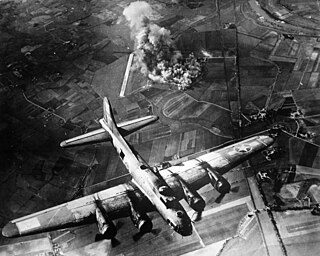
The Combined Bomber Offensive (CBO) was an Allied offensive of strategic bombing during World War II in Europe. The primary portion of the CBO was directed against Luftwaffe targets which were the highest priority from June 1943 to 1 April 1944. The subsequent highest priority campaigns were against V-weapon installations and petroleum, oil, and lubrication (POL) plants. Additional CBO targets included railyards and other transportation targets, particularly prior to the invasion of Normandy and, along with army equipment, in the final stages of the war in Europe.

Dehousing was a strategy adopted by the British against the Germans during World War II. It sought to maximize the damage to civilian housing. The strategy was proposed via a memorandum on March 30, 1942, by Professor Frederick Lindemann, Baron Cherwell, the British government's chief scientific adviser. He believed that this strategy would allow them to avoid an invasion of Europe. After it was accepted by the Cabinet, became known as the dehousing paper.

The Defence of the Reich is the name given to the strategic defensive aerial campaign fought by the Luftwaffe of Nazi Germany over German-occupied Europe and Germany during World War II against the Allied strategic bombing campaign. Its aim was to prevent the destruction of German civilians, military and civil industries by the Western Allies. The day and night air battles over Germany during the war involved thousands of aircraft, units and aerial engagements to counter the Allies bombing campaigns. The campaign was one of the longest in the history of aerial warfare and with the Battle of the Atlantic and the Allied naval blockade of Germany was the longest of the war. The Luftwaffe fighter force defended the airspace of German-occupied Europe against attack, first by RAF Bomber Command and then against the RAF and United States Army Air Forces (USAAF) in the Combined Bomber Offensive.

Nachtjagdgeschwader 3 was a Luftwaffe night fighter-wing of World War II. NJG 3 was formed on 29 September 1941 in Stade from Stab./Zerstörergeschwader 26. Pilots of NJG 3 claimed approximately 820 aerial victories by day and night.
Anthony Noble Frankland CB CBE DFC was a British historian who served as Director General of the Imperial War Museum.
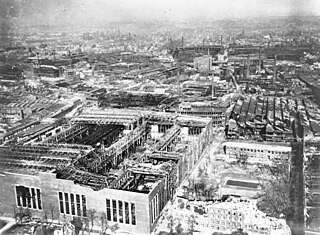
The Battle of the Ruhr was a strategic bombing campaign against the Ruhr Area in Nazi Germany carried out by RAF Bomber Command during the Second World War. The Ruhr was the main centre of German heavy industry with coke plants, steelworks, armaments factories and ten synthetic oil plants. The British attacked 26 targets identified in the Combined Bomber Offensive. Targets included the Krupp armament works (Essen), the Nordstern synthetic oil plant at Gelsenkirchen and the Rheinmetall–Borsig plant in Düsseldorf, which was evacuated during the battle. The battle included cities such as Cologne not in the Ruhr proper but which were in the larger Rhine-Ruhr region and considered part of the Ruhr industrial complex. Some targets were not sites of heavy industry but part of the production and movement of materiel.

Air warfare was a major component in all theaters of World War II and, together with anti-aircraft warfare, consumed a large fraction of the industrial output of the major powers. Germany and Japan depended on air forces that were closely integrated with land and naval forces; the Axis powers downplayed the advantage of fleets of strategic bombers and were late in appreciating the need to defend against Allied strategic bombing. By contrast, Britain and the United States took an approach that greatly emphasized strategic bombing and tactical control of the battlefield by air as well as adequate air defenses. Both Britain and the U.S. built substantially larger strategic forces of large, long-range bombers. Simultaneously, they built tactical air forces that could win air superiority over the battlefields, thereby giving vital assistance to ground troops. The U.S. Navy and Royal Navy also built a powerful naval-air component based on aircraft carriers, as did the Imperial Japanese Navy; these played the central role in the war at sea.

Haddock Force was the name given to a number of Royal Air Force bombers dispatched to airfields in southern France to bomb northern Italian industrial targets if Italy declared war, which was thought to be imminent. Italy entered the Second World War on 10 June 1940 and the plan was put into effect but at first, the local French authorities prevented the RAF Vickers Wellington bombers from taking off. Armstrong Whitworth Whitleys flying from England via the Channel Islands made the first raid on the night of 11/12 June 1940.
